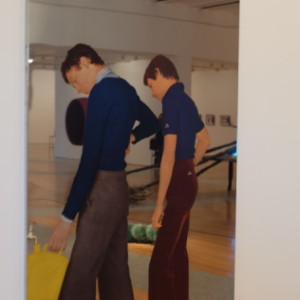The other side of the bridge
A 5 km ride on a tram to Belam - it felt longer - to look for the original building of the Lisbon custard tart and Centre for modern art. Both proved to be excellent and well worth the journey.
Having decided on no breakfast the tart cafe was the first place to visit and we managed 2 each with a coffee. The building was old, had character and was a labyrinth of places to sit and eat with the tiled walls and busy waiters producing savoury and sweet food. Loved it.
The centre for modern art was a few minutes walk from there and free. After yesterday's disapointing visit to the ancient arts this was fabulous. We only managed one floor but can always return. The photographs felt inspirational and one piece of art was a tall narrow mirror with two images of young men, one filling a can from a tap, the rest was a reflection of the room.
Outside into the sunshine and over the the monument, my image shows part of it, more info below. Overall the area was busy and many headed for the monastery, a huge place we had seen in a painting yesterday, we didn't fancy touring it today.
Back on the tram and a late lunch in the Time Out place and back to the apartment.
Custard tarts:
Pasteis de Nata, deliciously soft, sweet, custard tarts, are a cult in Lisbon. And one place is the undisputed master of making them. In Belem, just off the waterfront, is the Antiga Confeitaria de Belem - a blue and white-tiled temple to eggs, cream sugar and pastry. The 170-year-old recipe is a secret, divulged to only three chefs at a time. The result is delicious - perfectly browned, with individualism catered for with sachets of icing sugar and cinnamon. The cafe turns out 16,000 tarts a day, all hand-made on the premises and served warm. Worth a trip to Portugal in themselves.
The monument:
Monument of Discoveries on the bank of the river Tagus
It was built in 1960 on the occasion of the 500th anniversary of Henry the Navigator's death, he was a driving force behind the overseas exploration and financed many of the expeditions. The monument shows more than thirty statues of people who played an important role in the discoveries. Leading the way is Henry the Navigator who is shown standing on the bow holding a model of a caravel. Behind him are king Afonso V - who supported the exploration and colonization of Africa - and the explorers Vasco da Gama (who found a direct route to India), Pedro Álvares Cabral (discoverer of Brazil) and Ferdinand Magellan (the first explorer to circumnavigate the world). They are followed by navigators, writers, missionaries, a mathematician, a cartographer and other figures from the era of the discoveries.


Comments
Sign in or get an account to comment.


